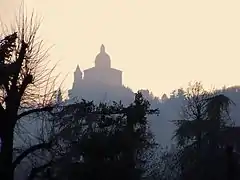Carlo Francesco Dotti | |
|---|---|
_-_BEIC_6330622.jpg.webp) | |
| Born | Baptized January 1, 1670 |
| Died | June 3, 1759 |
| Nationality | Bolognese |
| Occupation | Architect |
| Known for | Madonna di San Luca |

Carlo Francesco Dotti (baptized January 1, 1670 – June 3, 1759)[1] was an Italian architect from Bologna.
Life
Carlo Francesco Dotti was born and died in Bologna, where he became one of the main protagonists of the late Baroque style.
His most famous work is the Sanctuary of the Madonna di San Luca, Bologna, which is raised on a hilltop above the city, consisting of a church topped by an elliptical dome, with extensions leading to two pentagonal pavilions.[2]
In the first half of the eighteenth century he worked on the church of San Donato of Bologna, the university library and several palaces in the center of the city. In the Palazzo Davia Bargellini he executed the monumental staircase around 1730. He was also known for the Arch of Meloncello (1721); the altar of Ivo of Kermartin in the San Petronio Basilica; and the Renazzo parish church, in the town of Cento in the Province of Ferrara.
A street is named after him next to the road that leads up the Sanctuary of the Madonna di San Luca, just outside the center of Bologna.
Principal works
- Sanctuary of the Madonna of San Luca, 1723 - 1757 (Bologna)
- Restoration of the Basilica of San Domenico (Bologna), 1728 - 1732
- Reading room of the library of the University of Bologna
- Palazzo Agucchi, now Palazzo Bosdari, Bologna
- Palazzo Monti, now Palazzo Salina, Bologna
- Palazzo Poggi, Bologna
- Project for the great stairway of the Palazzo Davia Bargellini, Bologna
- Design for the Colonna dell'Immacolata, Piazza Malpighi, Bologna
- Arco del Meloncello, Bologna, 1732
- Parish church of San Giovanni, Minerbio
- Restoration of Malatesta temple, Rimini
References
Citations
- ↑ "DOTTI, Carlo Francesco in "Dizionario Biografico"". www.treccani.it (in Italian). Retrieved 2021-11-03.
- ↑ "Le Muse", De Agostini, Novara, 1965, Vol.IV, pag. 258.
Sources
